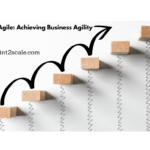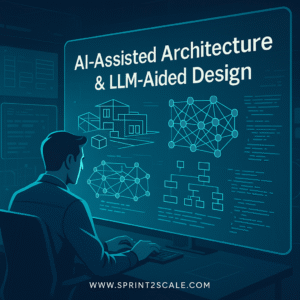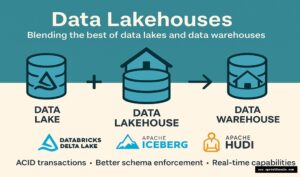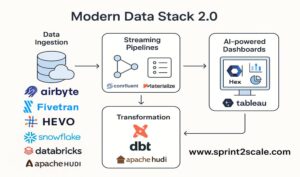Introduction
In the ever-evolving landscape of technology and business, agility has become a cornerstone for success. As we step into 2024, the principles and practices of Agile are not only enduring but are also undergoing dynamic transformations. This blog explores the Agile trends that are shaping the way teams and organizations approach software development, project management, and overall business strategies.
1. Hyper-Personalization in Agile Teams
Agile methodologies have traditionally focused on collaboration and adaptability. In 2024, there’s a noticeable shift towards hyper-personalization within Agile teams. This involves tailoring Agile processes and practices to better suit the individual strengths, preferences, and working styles of team members.
1.1. Role-specific Agile Frameworks
Teams are adopting role-specific Agile frameworks to optimize workflow. For instance, a development team might follow a slightly different Agile framework compared to a quality assurance team. This personalized approach ensures that each team member is operating in an environment that maximizes their efficiency and creativity.
1.2. Customized Workflows
Customized workflows within Agile tools are becoming increasingly popular. These tools allow teams to adapt the Agile framework to their unique needs. This level of personalization not only enhances productivity but also contributes to job satisfaction and employee retention.
2. Agile Beyond IT: Enterprise Agility
While Agile originated in the realm of software development, its principles are finding applications far beyond IT departments. In 2024, there is a growing emphasis on enterprise-wide agility, with organizations embracing Agile frameworks in various departments.
2.1. Agile Marketing
Marketing teams are adopting Agile practices to respond swiftly to market changes, experiment with campaigns, and measure results effectively. The iterative nature of Agile enables marketing teams to refine strategies based on real-time data and customer feedback.
2.2. HR and Agile
Human Resources (HR) departments are leveraging Agile methodologies for talent acquisition, performance management, and employee development. Agile HR practices ensure that organizations are not only hiring the right talent but also nurturing and retaining it effectively.
2.3. Agile Finance
Even finance departments are recognizing the benefits of Agile. Budgeting, forecasting, and financial analysis are being approached with an Agile mindset, allowing for faster adaptation to economic shifts and changes in business priorities.
3. DevOps and Agile Integration
In 2024, the collaboration between development and operations, commonly known as DevOps, is becoming an integral part of Agile methodologies. The integration of DevOps and Agile is streamlining the entire software development lifecycle.
3.1. Continuous Integration and Continuous Deployment (CI/CD)
CI/CD pipelines are now a standard component of Agile development. These pipelines automate the process of integrating code changes, testing, and deploying applications, ensuring a faster and more reliable release cycle.
3.2. Collaborative Tools for DevOps and Agile Teams
Collaborative tools that facilitate communication and cooperation between development and operations teams are gaining traction. These tools go beyond traditional project management tools to provide a seamless experience for teams practicing both Agile and DevOps.
3.3. Site Reliability Engineering (SRE) and Agile
The principles of SRE, focused on creating scalable and highly reliable software systems, are aligning with Agile methodologies. This convergence is improving the overall reliability and performance of software products while maintaining the flexibility inherent in Agile practices.
4. AI and Automation in Agile
As we step into 2024, artificial intelligence (AI) and automation are increasingly becoming integral to Agile practices. These technologies are not replacing human roles but are enhancing efficiency and providing new insights.
4.1. Automated Testing and QA in Agile
Automated testing tools are significantly reducing the time and effort required for quality assurance in Agile projects. These tools ensure faster feedback on code changes and improve the overall reliability of the software.
4.2. AI-powered Agile Analytics
AI is being applied to Agile analytics, providing teams with predictive insights into project timelines, potential risks, and resource allocation. Machine learning algorithms are helping teams make data-driven decisions, optimizing project outcomes.
4.3. Chatbots and Virtual Assistants for Agile Teams
Chatbots and virtual assistants are being employed to facilitate communication within Agile teams. These AI-driven tools help teams stay connected, provide instant information, and assist with routine tasks, allowing team members to focus on more complex and creative aspects of their work.
5. Remote Agile and Hybrid Work Models
The global shift towards remote work has significantly influenced Agile practices. In 2024, organizations are not only adapting to remote Agile but also exploring hybrid models that combine in-office and remote work.
5.1. Virtual Agile Ceremonies
Scrum ceremonies, such as sprint planning, daily stand-ups, and retrospectives, are conducted virtually, leveraging video conferencing tools. Virtual whiteboards and collaboration platforms are becoming essential for remote teams practicing Agile.
5.2. Flexible Work Hours in Agile Teams
To accommodate different time zones and personal preferences, Agile teams are adopting flexible work hours. This shift supports a better work-life balance for team members, contributing to increased job satisfaction and productivity.
5.3. Hybrid Agile Models
Some organizations are adopting hybrid Agile models that combine elements of traditional co-located Agile with remote work practices. This allows for the benefits of in-person collaboration while harnessing the flexibility of remote work.
6. Security in Agile Development
With the increasing frequency and sophistication of cyber threats, security is emerging as a critical consideration in Agile development. In 2024, Agile practices are incorporating security measures from the outset.
6.1. DevSecOps
DevSecOps, an evolution of DevOps, integrates security practices into the development process. Security is no longer a separate phase but is an integral part of the entire software development lifecycle, ensuring that applications are secure by design.
6.2. Agile Security Training
Agile teams are receiving specialized training in security practices. This includes secure coding guidelines, threat modeling, and understanding the implications of security decisions throughout the development process.
6.3. Automated Security Testing in Agile
Automated security testing tools are becoming standard in Agile development. These tools help identify vulnerabilities early in the development cycle, allowing teams to address security issues before they become critical.
7. Outcome-driven Agile Metrics
In 2024, the focus is shifting from traditional Agile metrics, such as velocity and burndown charts, to outcome-driven metrics that measure the real impact of Agile practices on business objectives.
7.1. Value Stream Mapping
Value stream mapping is gaining prominence as a metric that provides a holistic view of the end-to-end process, from ideation to delivery. This helps organizations identify bottlenecks and areas for improvement across the entire value chain.
7.2. Customer Satisfaction Metrics
Measuring customer satisfaction and feedback is becoming a key performance indicator for Agile teams. Customer-centric metrics provide valuable insights into the success of Agile projects from the end-user perspective.
7.3. Business Value Delivered
Rather than focusing solely on output metrics, Agile teams are emphasizing the measurement of business value delivered. This includes tracking the impact of features and improvements on key business objectives and outcomes.
8. Regulatory Compliance and Agile
As industries become more regulated, Agile is adapting to incorporate compliance requirements seamlessly into the development process.
8.1. Agile Compliance Frameworks
Specialized Agile compliance frameworks are emerging, providing guidelines for integrating compliance activities into Agile workflows. These frameworks ensure that regulatory requirements are met without compromising the agility of development processes.
8.2. Automated Compliance Testing
Automation is playing a crucial role in ensuring regulatory compliance in Agile projects. Automated compliance testing tools help teams verify that software meets the necessary regulatory standards throughout the development lifecycle.
8.3. Agile Documentation for Compliance
Agile documentation practices are evolving to accommodate compliance requirements. Clear and concise documentation is maintained throughout the development process, providing a transparent record of compliance activities.
Conclusion
As we look ahead to 2024, Agile continues to evolve, adapting to the changing landscape of technology, business, and work culture. The trends outlined in this blog represent not only the current state of Agile but also the direction it is heading. Embracing these trends can empower teams and organizations to navigate the complexities of modern development and business environments, fostering innovation, collaboration, and sustainable growth.







No Comment! Be the first one.